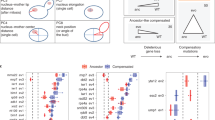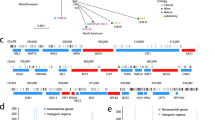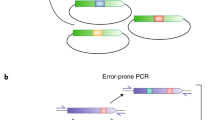Abstract
Phenotypes that might otherwise reveal a gene's function can be obscured by genes with overlapping function. This phenomenon is best known within gene families, in which an important shared function may only be revealed by mutating all family members. Here we describe the 'green monster' technology that enables precise deletion of many genes. In this method, a population of deletion strains with each deletion marked by an inducible green fluorescent protein reporter gene, is subjected to repeated rounds of mating, meiosis and flow-cytometric enrichment. This results in the aggregation of multiple deletion loci in single cells. The green monster strategy is potentially applicable to assembling other engineered alterations in any species with sex or alternative means of allelic assortment. To test the technology, we generated a single broadly drug-sensitive strain of Saccharomyces cerevisiae bearing precise deletions of all 16 ATP-binding cassette transporters within clades associated with multidrug resistance.
This is a preview of subscription content, access via your institution
Access options
Subscribe to this journal
Receive 12 print issues and online access
$259.00 per year
only $21.58 per issue
Buy this article
- Purchase on Springer Link
- Instant access to full article PDF
Prices may be subject to local taxes which are calculated during checkout



Similar content being viewed by others
References
Tong, A.H. et al. Global mapping of the yeast genetic interaction network. Science 303, 808–813 (2004).
Costanzo, M. et al. The genetic landscape of a cell. Science 327, 425–431 (2010).
Beh, C.T., Cool, L., Phillips, J. & Rine, J. Overlapping functions of the yeast oxysterol-binding protein homologues. Genetics 157, 1117–1140 (2001).
Pruess, M. et al. The Proteome Analysis database: a tool for the in silico analysis of whole proteomes. Nucleic Acids Res. 31, 414–417 (2003).
Decottignies, A. et al. ATPase and multidrug transport activities of the overexpressed yeast ABC protein Yor1p. J. Biol. Chem. 273, 12612–12622 (1998).
Entwistle, R.A., Winefield, R.D., Foland, T.B., Lushington, G.H. & Himes, R.H. The paclitaxel site in tubulin probed by site-directed mutagenesis of Saccharomyces cerevisiae beta-tubulin. FEBS Lett. 582, 2467–2470 (2008).
Nakamura, K. et al. Functional expression of Candida albicans drug efflux pump Cdr1p in a Saccharomyces cerevisiae strain deficient in membrane transporters. Antimicrob. Agents Chemother. 45, 3366–3374 (2001).
Decottignies, A. & Goffeau, A. Complete inventory of the yeast ABC proteins. Nat. Genet. 15, 137–145 (1997).
Ernst, R., Klemm, R., Schmitt, L. & Kuchler, K. Yeast ATP-binding cassette transporters: cellular cleaning pumps. Methods Enzymol. 400, 460–484 (2005).
Rothstein, R.J. One-step gene disruption in yeast. Methods Enzymol. 101, 202–211 (1983).
Alani, E., Cao, L. & Kleckner, N. A method for gene disruption that allows repeated use of URA3 selection in the construction of multiply disrupted yeast strains. Genetics 116, 541–545 (1987).
Akada, R. et al. PCR-mediated seamless gene deletion and marker recycling in Saccharomyces cerevisiae. Yeast 23, 399–405 (2006).
Davidson, J.F. & Schiestl, R.H. Mis-targeting of multiple gene disruption constructs containing hisG. Curr. Genet. 38, 188–190 (2000).
Guldener, U., Heck, S., Fielder, T., Beinhauer, J. & Hegemann, J.H. A new efficient gene disruption cassette for repeated use in budding yeast. Nucleic Acids Res. 24, 2519–2524 (1996).
Delneri, D. et al. Exploring redundancy in the yeast genome: an improved strategy for use of the cre-loxP system. Gene 252, 127–135 (2000).
Wieczorke, R. et al. Concurrent knock-out of at least 20 transporter genes is required to block uptake of hexoses in Saccharomyces cerevisiae. FEBS Lett. 464, 123–128 (1999).
Storici, F., Lewis, L.K. & Resnick, M.A. In vivo site-directed mutagenesis using oligonucleotides. Nat. Biotechnol. 19, 773–776 (2001).
Wach, A., Brachat, A., Alberti-Segui, C., Rebischung, C. & Philippsen, P. Heterologous HIS3 marker and GFP reporter modules for PCR-targeting in Saccharomyces cerevisiae. Yeast 13, 1065–1075 (1997).
Tong, A. & Boone, C. High-throughput strain construction and systematic synthetic lethal screening in Saccharomyces cerevisiae. in Methods in Microbiology (eds., Stansfield, I. & Stark, M.J.R.) vol. 36, 369–386 (Elsevier, 2007).
Goldstein, A.L. & McCusker, J.H. Three new dominant drug resistance cassettes for gene disruption in Saccharomyces cerevisiae. Yeast 15, 1541–1553 (1999).
Gossen, M. et al. Transcriptional activation by tetracyclines in mammalian cells. Science 268, 1766–1769 (1995).
Ben-Aroya, S. et al. Toward a comprehensive temperature-sensitive mutant repository of the essential genes of Saccharomyces cerevisiae. Mol. Cell 30, 248–258 (2008).
Breslow, D.K. et al. A comprehensive strategy enabling high-resolution functional analysis of the yeast genome. Nat. Methods 5, 711–718 (2008).
Winzeler, E.A. et al. Functional characterization of the S. cerevisiae genome by gene deletion and parallel analysis. Science 285, 901–906 (1999).
Kolaczkowska, A., Kolaczkowski, M., Goffeau, A. & Moye-Rowley, W.S. Compensatory activation of the multidrug transporters Pdr5p, Snq2p, and Yor1p by Pdr1p in Saccharomyces cerevisiae. FEBS Lett. 582, 977–983 (2008).
St Onge, R.P. et al. Systematic pathway analysis using high-resolution fitness profiling of combinatorial gene deletions. Nat. Genet. 39, 199–206 (2007).
Rees, D.C., Johnson, E. & Lewinson, O. ABC transporters: the power to change. Nat. Rev. Mol. Cell Biol. 10, 218–227 (2009).
Dean, M. ABC transporters, drug resistance, and cancer stem cells. J. Mammary Gland Biol. Neoplasia 14, 3–9 (2009).
Jeong, H., Herskowitz, I., Kroetz, D.L. & Rine, J. Function-altering SNPs in the human multidrug transporter gene ABCB1 identified using a Saccharomyces-based assay. PLoS Genet. 3, e39 (2007).
Hughes, T.R. et al. Widespread aneuploidy revealed by DNA microarray expression profiling. Nat. Genet. 25, 333–337 (2000).
Brachmann, C.B. et al. Designer deletion strains derived from Saccharomyces cerevisiae S288C: a useful set of strains and plasmids for PCR-mediated gene disruption and other applications. Yeast 14, 115–132 (1998).
Belli, G., Gari, E., Piedrafita, L., Aldea, M. & Herrero, E. An activator/repressor dual system allows tight tetracycline-regulated gene expression in budding yeast. Nucleic Acids Res. 26, 942–947 (1998).
Gossen, M. & Bujard, H. Tight control of gene expression in mammalian cells by tetracycline-responsive promoters. Proc. Natl. Acad. Sci. USA 89, 5547–5551 (1992).
Urlinger, S. et al. Exploring the sequence space for tetracycline-dependent transcriptional activators: novel mutations yield expanded range and sensitivity. Proc. Natl. Acad. Sci. USA 97, 7963–7968 (2000).
Acknowledgements
This work was supported by US National Institutes of Health grants R01 HG003224 and R21 CA130266 to F.P.R. O.D.K. was supported by a National Research Service Award fellowship from the National Institutes of Health–National Human Genome Research Institute. Micrographs were generated at Nikon Imaging Center at Harvard Medical School. We are grateful for yeast strains from C. Boone (University of Toronto) and A. Goffeau (Université catholique de Louvain), and for advice and assistance from M. Al-Shawi, B.J. Andrews, C. Baisden, R. Balasubramanian, W. Bender, C. Boone, R. Brost, S. Buratowski, D. Chowdhury, G.M. Church, D. Coen, E. Craig, E. Elion, M. Fenerjian, D. Gibson, J. Glass, A. Goffeau, R. Grene, C. Hutchison, S. Iwase, M. Johnston, B. Karas, K. Kono, K. Kuchler, J. Li, D. Morgan, S. Moye-Rowley, J. Murai, S. Oliver, F. Ozbek, Y. Pan, D. Pellman, A. Ramon, J. Rine, A. Rowat, P. Silver, H. Smith, M. Springer, K. Struhl, C. Tagwerker, M. Takahashi, B. Turcotte, D. Weitz and S. Yoshida; members of the Roth Lab, especially M. Tasan, J. Mellor, J. Komisarof, J. MacKay, A. Derti and S. Komili; and members of the Dana-Farber Center for Cancer Systems Biology, especially P. Braun, A. Dricot, D. Hill, Q. Li and H. Yu.
Author information
Authors and Affiliations
Contributions
Y.S. and F.P.R. developed the green monster method and prepared the manuscript; R.P.S.O., A.H., J.L. and Y.S. measured drug sensitivity; R.M. analyzed growth curves; O.D.K. simulated the process; L.V.Z., C.N. and G.G. advised on method design; A.H.Y.T., V.M.L., V.N.G. and M.V. provided reagents and advice; W.C. and L.P. provided technical support; P.S. and Y.S. performed flow cytometry.
Corresponding authors
Ethics declarations
Competing interests
The authors declare no competing financial interests.
Supplementary information
Supplementary Text and Figures
Supplementary Figures 1–8 and Supplementary Tables 1–13 (PDF 4210 kb)
Rights and permissions
About this article
Cite this article
Suzuki, Y., Onge, R., Mani, R. et al. Knocking out multigene redundancies via cycles of sexual assortment and fluorescence selection. Nat Methods 8, 159–164 (2011). https://doi.org/10.1038/nmeth.1550
Received:
Accepted:
Published:
Issue Date:
DOI: https://doi.org/10.1038/nmeth.1550
This article is cited by
-
Microbial communities form rich extracellular metabolomes that foster metabolic interactions and promote drug tolerance
Nature Microbiology (2022)
-
Pan-active imidazolopiperazine antimalarials target the Plasmodium falciparum intracellular secretory pathway
Nature Communications (2020)
-
Yeast genetic interaction screens in the age of CRISPR/Cas
Current Genetics (2019)
-
A lavender ABC transporter confers resistance to monoterpene toxicity in yeast
Planta (2019)
-
Integrated transcriptomic analysis of Trichosporon Asahii uncovers the core genes and pathways of fluconazole resistance
Scientific Reports (2017)



